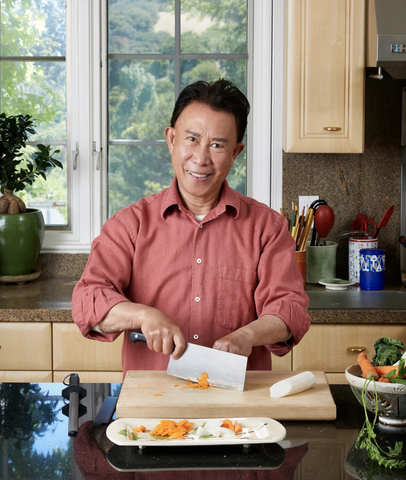Celebrating Lunar New Year with Peanuts & Peanut Butter

To celebrate Lunar New Year, we asked Yan Can Cook’s Martin Yan to share some of his favorite parts of the celebration, along with recipes that explore the deep roots that peanuts have in Chinese cuisine.
Guest post by Martin Yan, food photography by Stephen Klise, and food styling by Elle Simone Scott

According to the lunar calendar, 2022 is the Year of the Tiger. The Lunar New Year, which is sometimes called Chinese New Year, is celebrated in China as well as several other Asian countries, and is also sometimes known as the Spring Festival. It’s a holiday that is very special for many people because of how it brings families together. On the evening before the start of the new year, families gather for the “reunion dinner,” an elaborate meal with a variety of dishes that are both traditional and symbolic. Some of the most common are:
Sweet Glutinous Rice Cake: made of glutinous or sweet glutinous rice flour, these can be savory or sweet (and even filled with peanuts or peanut butter). The Chinese characters in the name mean continued success and prosperity.
Whole Fish: one of the most prominent dishes served during the Lunar New Year, the pronunciation for fish “yu” means abundance / plentiful. By serving it, you are in fact wishing your guests an abundance of wealth and food in the new year.
Dumplings: these small morsels resemble ingots – ancient gold or silver pieces, symbolizing wealth and good fortune.
Noodles: a “must have” dish in all celebrations because of the strands which symbolize long life. Noodles can be served in a variety of ways – in soups, salads, stir-frys, pan-fried, and even desserts.
Citrus Fruits: one of the most common foods to see during lunar new year. The pronunciation of the Chinese word for tangerine sounds like "gold" and the color orange. Another citrus fruit, pomelo, in Chinese means “abundance” – lots of leftovers. They are always on the table and are also traditional gifts because of their symbolism.

Chef Yan (left) & friends at a Lunar New Year Celebration in 2014
When I was growing up as a kid in China I always looked forward to Lunar New Year. Our family’s reunion dinner was one of the rare occasions when I would see all my relatives. The next morning, New Year’s Day, all us young kids would wake up early, anxiously awaiting to receive red envelopes with “lucky money” tucked inside. There would also be plenty of New Year’s candy for us to enjoy.
In observance of the Buddhist commandment “thou shalt not kill,” sharp objects were not allowed to be used on New Year’s Day, so the meat dishes were prepared ahead of time, and a lot of vegetarian dishes would always be included. For the next seven days, there would be a huge spread of foods and gifts in every household. As peanuts are a favorite ingredient in China, they would be included in a variety of dishes served during the New Year. One of my personal favorites were the glutinous rice balls with a peanut butter filling, served in a hot sweet ginger syrup. Even today it remains a favorite and reminds me of my childhood.
The majority of China’s peanut production is based in northern China, mainly in the Shandong province, but peanuts are also planted in Guangdong province. Like most countries, peanuts in China are mainly grown to extract their oil after harvest. Along with refined peanut oil which does not have much flavor, in China peanut oil made from roasted peanuts is also widely used. The peanut aroma from this oil is much more pronounced than that of the refined oil, which is more common in Western cooking. If you haven’t tasted it before, the peanut oil from roasted peanuts tastes a little like sesame oil, but it has a pronounced nutty aroma.
Peanuts are widely used in Chinese cuisine – both in the home kitchen as well as in restaurants. Peanuts and ground peanuts (peanut butter) are used in various ways in the Chinese kitchen - in appetizers, salads, main entrees and desserts, as well as sauces and dressings. Traditional Chinese cooking recognizes that the nutritional components of peanuts are beneficial and key components to a balanced diet.
 |
 |
If you are planning a Lunar New Year celebration, these are some delicious and easy-to-prepare dished incorporating peanuts and peanut butter into your menu:
Firecracker Chicken (also known as Kung Pao Chicken)
Good Fortune Crystal Wraps
Longevity Noodles with Peanut Sauce
Another important Lunar New Year tradition is the Dragon Dance, which dates back to the Han Dynasty (206 BC-24 AD). Its original intention was to please the ancestors and to pray for rain during harvest. It is believed that the Dragon represents power, wisdom and wealth and that it would bring good luck for the new year.
Lunar New Year is such a special and important time of year. It’s a time to reflect, to celebrate age-old traditions, bring families and friends together, and of course enjoy delicious food.
I wish you good health and much happiness in the new year!
Celebrate Lunar New Year with peanutty dishes! Get the recipes: Firecracker Chicken, Crystal Lettuce Wraps, Longevity Noodles
As part of our celebration of Lunar New Year in 2022, Peanut Butter & Co. has made a donation to the Asia Pacific Fund.


